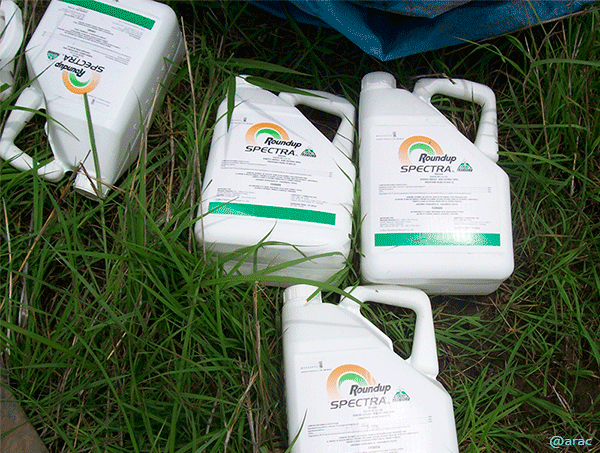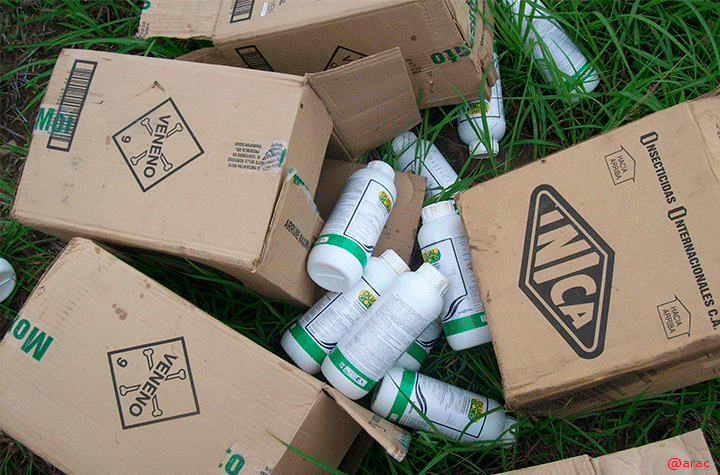Aliendres, A.
Maturín, 14/10/2019
Dear readers.
In this opportunity I share information regarding environmental degradation and contamination due to the use and abuse of agrotoxic, which threaten the biota and destroy important components of the biotope (soil and water). I invite you to review the information on this daunting agricultural outlook.


The origin of agrotoxins has a bloody history, its first use was to kill people (soldiers) in the First World War; later, the range of toxic products will be expanded for this purpose and in the Second World War, it would be used again, especially for the collective elimination of Jewish citizens. Once the war was over, international treaties prohibited its use as a chemical weapon; however, its production for agricultural purposes was promoted.

Thus, in 1970 with the launch of the captious Green Revolution, which was supposedly the solution to solve the agrifood problem facing the world, the production, distribution and use of these poisons expanded. In December 1984, more than 3000 dead and 220,000 wounded, without qualifying the damage to biodiversity and the environment in general, occur after an unfortunate disaster in the chemical factory of Bhopal - India. The consequences are still evident in the city of Bhopal and its large body of water, the wonderful Lake Bhojtal that suffered severe pollution from liquid and gaseous effluents.
The human losses from this tragedy exceeded 25,000 victims in a few weeks. In 1989, during the Iraq invasion of Kuwait, Saddam Hussein's army would use large quantities of mustard gas, while the US army would not be more noble, it used nepal, a highly inflammable chemical compound. The human losses from these two terrible chemicals will never be known.

A wide range of problems trigger a long list of environmental, ecological, social and economic consequences that last for decades. Most agro-toxins are very soluble, so low doses should be used in larger amounts of water; this characteristic makes it extremely dangerous. When it is applied, one part remains in the vegetation cover, earth and another is suspended to travel up to hundreds of kilometers by the action of the wind.
Mechanized irrigation and rainfall are responsible for dragging these substances to aquifers (groundwater) through infiltration; runoff and ditches lead elsewhere to the nearest natural surface water bodies (streams, lagoons, lakes, springs, rivers and morichals); While the gases that have been suspended will contaminate soils and plants in wild ecosystems, another part is inhaled by people close to the area of application (workers and neighbors) who absorb these substances and, depending on the quantity, experience gradual poisoning and severe damage to their health. Meanwhile, it is necessary to promote campaigns of ecological methods to control pests and fertilize crops.

References [Spanish]
Key evidence withheld as 'trade secret' in EU's controversial risk assessment of glyphosate link
Glyphosate Issue Paper:Evaluation of Carcinogenic Potential link
Bhopal: The World's Worst Industrial Disaster, 30 Years Later link

- Photographs 1 and 3 were taken with KODAK EASYSHARE C613 camera.
𝐆𝐫𝐚𝐭𝐞𝐟𝐮𝐥 𝐟𝐨𝐫 𝐲𝐨𝐮𝐫 𝐢𝐧𝐭𝐞𝐫𝐞𝐬𝐭 𝐚𝐧𝐝 𝐫𝐞𝐚𝐝𝐢𝐧𝐠 𝐢𝐧 𝐭𝐡𝐢𝐬 𝐚𝐫𝐭𝐢𝐜𝐥𝐞. 𝐈𝐟 𝐲𝐨𝐮 𝐭𝐡𝐢𝐧𝐤 𝐢𝐭 𝐰𝐚𝐬 𝐮𝐬𝐞𝐟𝐮𝐥, 𝐬𝐡𝐚𝐫𝐞 𝐢𝐭 𝐰𝐢𝐭𝐡 𝐲𝐨𝐮𝐫 𝐟𝐫𝐢𝐞𝐧𝐝𝐬, 𝐟𝐫𝐢𝐞𝐧𝐝𝐬 𝐚𝐧𝐝 𝐟𝐨𝐥𝐥𝐨𝐰𝐞𝐫𝐬.

Thanks for sharing:)
Questo post è stato condiviso e votato dal team di curatori di discovery-it.
This post was shared and voted by the curators team of discovery-it
Hi. What a pretty surprise. Thanks for supporting my post. The support vote is from the @ discovery-it account?
Well, I look forward to that vote 😃
@tipu curate
Upvoted 👌
It is recommended to use content references in English if the publication is in the universal language. Regardless of whether the content provided belongs to references in Spanish.
Thanks to the good observation about the proper use of documentary references, I was able to correct the error. From now on, I keep that in mind so as not to make mistakes.
Happy day